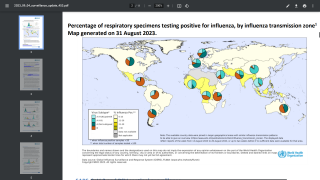9,697 Influenza-Related Deaths Reported Last Flu Season

While we do not know exactly what the coming influenza season will look like, flu seasons create significant public health burdens every winter, wrote the U.S. Centers for Disease Control and Prevention (CDC).
On September 28, 2023, the CDC reaffirmed for persons aged ≥six months, receiving a flu shot each year remains the best way to protect against seasonal influenza and its potentially severe consequences.
When reviewing the last flu season, vaccinations could be why influenza-related deaths were far below the CDC's forecast.
The CDC had forecasted 17,000 – 98,000 flu deaths.
The good news is the CDC today confirmed that as of September 14, 2023, the number of death certificates with influenza listed as an underlying or contributing cause of death during the 2022-23 season was 9,697.
And the number of pediatric deaths reported this flu season was 174. The mean age at death was seven years.
Among the children and adolescents who were eligible for influenza vaccination and for whom vaccination status was known, 83% were not fully vaccinated.
Furthermore, in hospitalized children and adolescents with information about underlying conditions, 66.1% reported at least one underlying medical condition, such as asthma, neurologic disease, and obesity.
The 2022-2023 data is lower than the recent peak in 2019-2020 when 199 pediatric deaths were confirmed.
According to the CDC, last flu season marked a return to influenza activity at levels more similar to those before the recent pandemic.
As reported to CDC from clinical laboratories, the peak percentage of specimens testing positive for influenza (26.3%) was similar to the average peak percentage positive during the 2015-16 – 2019-20 flu seasons.
Similarly, the cumulative rate of influenza-associated hospitalizations as reported last season was similar to hospitalization rates for 2014-15, 2016-17, 2018-19, and 2019-20 seasons and higher than all but one remaining season (2017-18 season) since the 2010-11 season.
Most importantly, this CDC data identifies the week ending December 17, 2022 (week #50) as the peak, which indicates people should get their annual flu shot earlier than the winter holidays.
Global trends for the 2023-2024 flu season are updated weekly.
This CDC report describes the extent and timing of influenza activity in the United States during the 2022-23 influenza season (October 2, 2022 – September 9, 2023) as reported to CDC by clinical and public health laboratories, outpatient providers, emergency departments, hospitals, vital statistics offices, and public health departments.
Furthermore, the CDC does not know the exact number of people who have been sick and affected by influenza because influenza is not a reportable disease in most areas of the U.S.
Our Trust Standards: Medical Advisory Committee
























